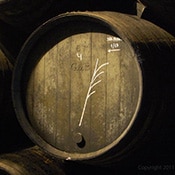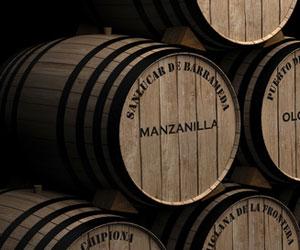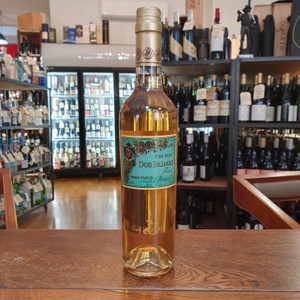
Nose: intense, with quite a lot of exotic spices (aniseed, cardamom) alongside nutty notes (almonds, walnuts) and dark caramel. Dried prunes. Liquorice roots and tobacco leaves. Hints of waxed old furniture and oil paintings. Flax ropes and very light iodine. Cocoa notes as well. Huge complexity, all the way from bone dry to rounded aromas.
Mouth: elegant and silky smooth, but with an impressively powerful entry. Good salty / sour balance. Hints of dry Madeira wines. Quite some salty / maritime notes as well as some lemon. Ponzu sauce. Sultanas. A clear wood influence, but still within limits, especially if you consider its age. A spicy aftertaste, with a lot of varnishy notes again. Overall surprisingly round. Very long finish.
The Palmas series shows the evolution of a fino, from the Una Palma (a young wine), over Dos Palmas and Tres Palmas all the way through to Cuatro Palmas (a mature Amontillado). In a way they are four still images, taken at different stages in the life of the same base wine that is Tio Pepe. The selection was made by Antonio Flores, the capataz of González Byass, and we think it’s great to see a big and commercial bodega produce such innovative, ’boutique’ sherries as well.
Since the 1880’s González Byass has used the Palmas system to classify quality Finos. The traditional ‘palma’ chalk mark was made on the barrel to indicate wines of exceptional finesse and delicacy of aroma. Over time they would earn more ‘palmas’ with the oldest and rarest casks bearing four marks.

Delgado Zuleta
Palomino
Sanlucar de Barrameda
Sanlucar de Barrameda, a historic coastal town in Andalucia, is the home of refreshing, sea-scented Manzanilla Sherry. The town's humid, maritime air creates an ideal environment for the development of flor yeasts – the secret behind Manzanilla's distinctive taste and aroma.
The Manzanilla DO (Denominación de Origen), created in 1933, covers exactly the same geographical area as the Jerez DO and the Palomino Fino grapes that go into the base wine can be grown anywhere in the Jerez viticultural area. What separates the two is the all-important barrel maturation stage, which must take place in Sanlucar.

Located on the left bank of the Guadalquivir estuary, Sanlucar de Barrameda is the northernmost point of the famous "Sherry Triangle", which is completed by El Puerto de Santa Maria (24km/15 miles south, along the coast) and Jerez de la Frontera (24km/15 miles southeast and inland).
Sanlucar's particular location was critical in the development of the Manzanilla style of Sherry for two reasons. The first is the moist seaside air here, which both encourages prolific flor growth and imparts a gently saline note to the wines.
Proximity to the Atlantic means that both summer and winter are less harsh here than in Jerez de la Frontera, so the heat-sensitive flor can survive all year round. This both increases the yeasty, fresh-bread character of the wine and imparts distinctive notes of almonds and camomile ("manzanilla" in Spanish).
The flor also continuously protects the wine from oxygen, preventing it from developing into an oxidative Amontillado or Oloroso style. If the wine is left to age for so long that the flor does eventually die, the resulting wine is known as "Manzanilla Olorosa" and then a "Manzanilla Pasada".
The second reason relates to Sanlucar's strategic value as a port. Not only does the town sit at the very center of Spain's (relatively short) stretch of Atlantic coastline, it also happens to be just 72km (45 miles) downstream from Seville, Andalucia's ancient capital.
This made it an obvious base for Spain's explorers to set out on their voyages during the Age of Discovery (both Columbus and Magellan launched voyages from the town), and later as a key transatlantic trading post.
As transatlantic trading burgeoned, so Sanlucar became increasingly important. Vast quantities of wine were stored there, and over time the traders observed a subtly different style of wine emerging – the style we now know as Manzanilla.








